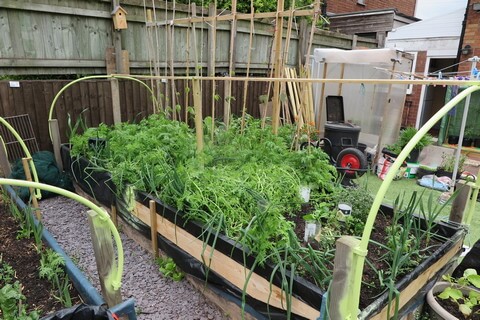The Soil
Let’s explore everything about the soil (of course) and its health.

We look at the soil as a interactive system; in fact it responds as a complete living being just like plants and animals (in which we humans are included). In its natural state, it is a system that will support everything living on it without effort. It has had 4.5 billion years to perfect it!
Digging
When we dig (or plough or till) the earth, it is locally destroyed like if you stuck a spade in a living being. All microorganisms in soil are exposed to the air which is not their habitat, so most will die. Left alone, the weed seeds (some unlocked from the soil, some airborne) will start to grow. This is the earth’s automatic healing system. It is like if we cut ourselves, the blood will clot over the wound until the tissue underneath heals.
But if we keep weeding bare soil, it is like if we continually pick the clot on our wound. It will not heal. The soil become less vital for plants because the essential microorganisms cannot get re-established. Microorganisms need plants in the soil to interact with to flourish.
In some big industrial farming areas, the weeds and their seeds will have been eliminated by herbicides. So the earth cannot heal itself and the weather (rain, wind and sun) will start turning the land into a desert. Desertification has happened in many areas of the world and we are losing agriculture land big-time.
Structure
Accepted wisdom says that digging improves the structure of the soil for growing plants. Actually this job is best done by …. earthworms! A dug bed will have a very coarse texture and if it is clayey, impossible to have a fine tilth for planting. Worms produce a fine texture that is great for plants. That is what nature evolve them to do and they do it excellently.
Digging will disturb the worms an even kill them. if they survive, they will move elsewhere that is safer. When I made this no-dig bed, I planted two boxes of worms bought on ebay.

Another disadvantage of digging is that the coarse texture created with the earth is ideal for slugs to live in. They happily hide in the nooks and crannies you created and come out at night to devour your plants. My no-dig beds have very little slug damage to plants compared to the one that has been dug.
Replacing Nutrients
The ideal nutrients for the soil yet again, are the examples set by nature. In the natural environment, plants that grow and eventually die decomposes and replenishes the soil life. Then wildlife that passes through the land, whether grazing or not, will deposit their stools and these are broken down and consumed by a variety of organisms and eventually becomes part of the earth making it richer.
Yes, these are processes that take time. However in our gardens, we can speed things up. We can make our own compost by piling up expired vegetation and the pile will become soil food within a few months. Or even quicker is to buy compost from the many stores that sell them in bags. Compost is rich in nutrients that can immediately help a seed germinate or nurture a young seedling as it grows. But without the essential microorganisms, the plant cannot grow healthily in the longer term. Extra feeding then becomes necessary.
When planted out in a bed, the un-dug soil microbiome will look after its needs for its lifetime (until harvest time). Not very obvious is how the organisms in healthy soil will help fend off any pathogens that may attack the plant. In turn, the plant uses carbon from the air and through photosynthesis produce carbon rich exudates from its roots to feed the helping organisms. This way, the carbon in the atmosphere is pulled back into the earth. It is a beautifully efficient system that has been going on forever.
So just using isolated N-P-K fertilisers in a dug bed just helps make up the building blocks of the plant cells. The symbiotic effects with other soil inhabitants would be missing. So the plant would not be as strong and resistant to pathogens. One suspects that when eating the plant, the nutrient levels that humans need might not be fully present either. Hence our resistance to pathogens (our immune system) could well be under par.
When it comes to manure, if you can get it from a “clean” source it could be very good for the soil. However, I would like to repeat my previous warning below.
A little warning here - manure can be dependent on the pasture/feed the livestock grazes on. Some pasture are treated with a weed-killer that survives the digestive system of the animal. The manure from these animals will kill your plants unless they are grass! This is also true of the hay that is gathered from treated land. Look up “aminopyralid” with brand names of Grazon, Banish, Forefront, Halcyon, Pharaoh, Pro-Banish, Runway, Synero, and Upfront.